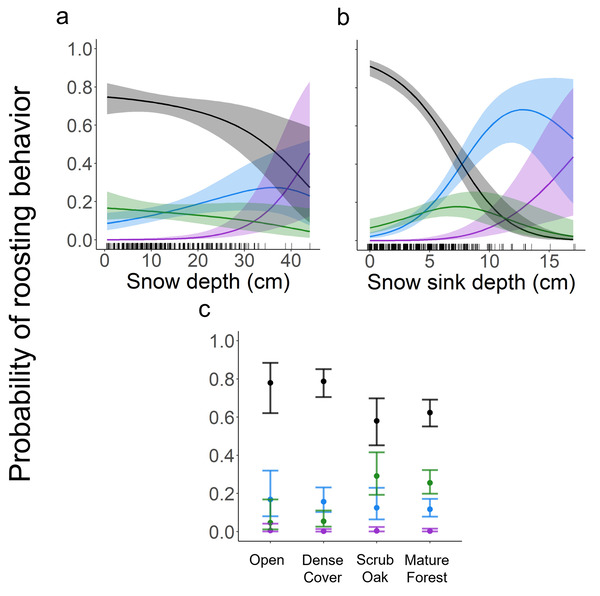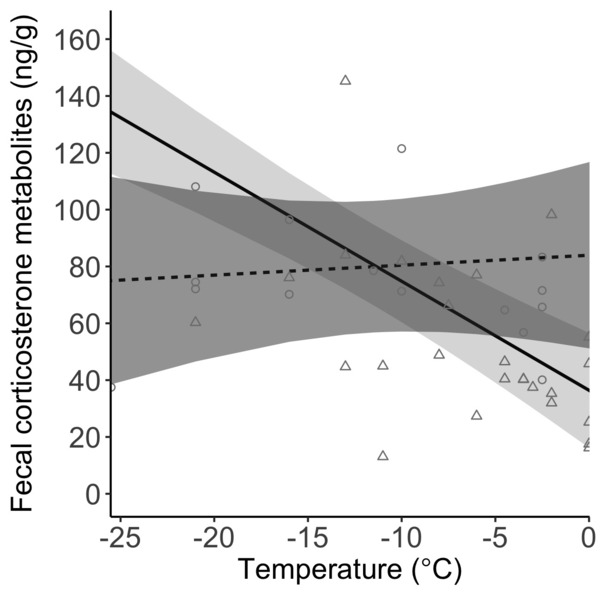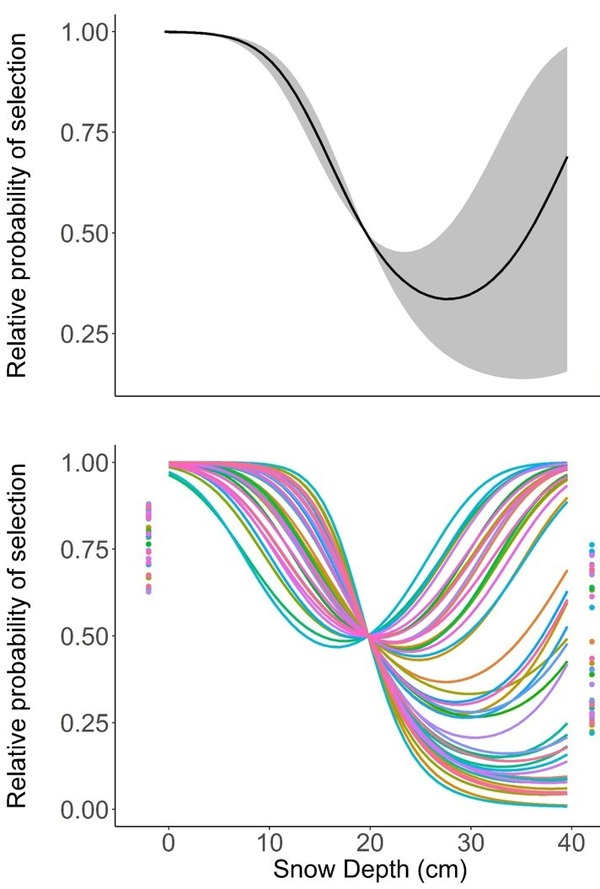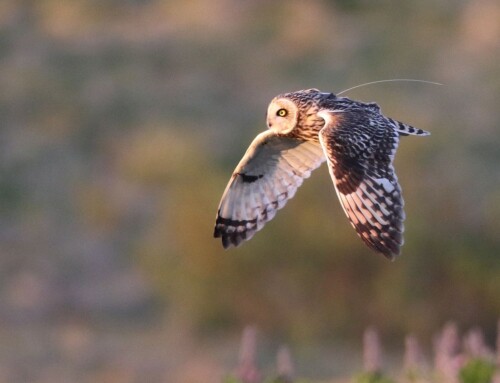 LINKED PAPER
LINKED PAPER
Snow cover constrains the behavioural flexibility of a winter-adapted bird. Shipley, A.A. & Zuckerberg B. 2023 Ibis. doi: 10.1111/ibi.13211 VIEW
Seeking out microrefugia, or localised patches of more stable conditions that buffer animals from harsh conditions, is an important behavioural adaptation. Microrefugia may be particularly important in winter, which is a time of resource scarcity and extreme conditions. In temperate regions, the subnivium, or the area under the snowpack, is an important microrefugium for a variety of plant and animal species. Snow functions as insulation and provides a stable thermal environment. However, snow is ephemeral, and the conditions that promote the stability of the subnivium are deteriorating with modern climate change. Snow cover is becoming more variable and disappearing earlier in the spring, and freeze-thaw events harden the snow.
It is unclear how species that use snow as a microrefugium adjust their behaviour with changing conditions. Our goal was to explore the environmental conditions that promote the use of the subnivium by a winter-adapted bird, the Ruffed Grouse (Bonasa umbellus), and assess the benefits to grouse when they use the subnivium.
The Ruffed Grouse is a resident species of forests across much of Canada and the northern United States. In winter, Ruffed Grouse can spend up to 80% of their time roosting. They can roost in trees, on the ground under shrubby cover, or in snow bowls or snow burrows that they create. We conducted a radio telemetry study (2015-2018) of Ruffed Grouse snow burrow use in central Wisconsin, USA. We monitored grouse winter roosting behaviour and weather conditions, collected grouse fecal droppings to measure corticosterone (stress levels), and documented grouse mortality.
We found non-linear relationships between the use of snow bowls and snow burrows and winter weather conditions. When snow was very shallow, grouse frequently roosted on top of the snow. Grouse were able to use snow bowls when snow was around 10 cm, but grouse seem to need about 15-20 cm for snow burrowing to become possible. When snow depth exceeded 30 cm grouse rapidly increased their use of snow burrows. When snow was very hard, grouse roosted on top of the snow almost exclusively, but as snow became more powdery, they rapidly switched over to snow bowls and snow burrows. However, grouse did not increase their use of snow burrows when temperatures were cold, which indicates that using snow burrows may confer additional benefits beyond insulation, such as protection from predators. While roosting behaviour was not generally associated with land cover, we found that in open habitat grouse were more willing to use snow burrows and bowls at shallower snow depths. This further indicates that using snow burrows may keep grouse hidden from predators (Shipley et al. 2023).

Figure 1 Partial dependency plots showing the effects of (a) snow depth (cm); (b) snow sink depth (cm; larger values indicate more powdery snow), and (c) land cover classes on the probability of Ruffed Grouse using snow burrows (purple), snow bowls (blue), surface roosts (black), or tree roosts (green). Lines and shaded bands (a, b) and points and error bars (c) represent means and 95% confidence intervals. Vertical tick marks indicate observed snow depth (a) and observed snow sink depth (b) at roost sites. The probability of grouse using snow bowls increased steadily as snow depths increased from 0-35 cm, but the probability of snow burrowing increased considerably only between 20-40 cm snow depth. The probability of using snow bowls quickly increased with increasing snow sink depth, but grouse did not use snow burrows unless snow was considerably more powdery.
Glucocorticoid stress hormones help animals respond to a variety of stressors, including food shortages, inclement weather, or predators. However, there can be fitness consequences if stress hormones remain chronically elevated, and there is very little information on how snow cover and cold temperatures influence the stress physiology of animals adapted to cope with a winter environment.
We found a strong relationship between corticosterone (the glucocorticoid stress hormone in birds) and winter temperature. Grouse had significantly higher corticosterone levels when temperatures were cold and more energy is required for thermoregulation. Importantly, we found that when grouse used snow burrows, this relationship was effectively erased, and grouse stress levels were unaffected by outside air temperature. We also found that when snow depths were relatively shallow (below 20 cm), grouse stress levels were high, but as snow depth increased beyond 20 cm, stress rapidly decreased (Shipley et al. 2019). Further, grouse were more stressed when they were in larger open areas, which may further indicate perceived risk of predation in open habitats (Shipley et al. 2022).

Figure 2 Partial residual plot of the interaction between ambient temperature and roost site and ruffed grouse fecal corticosterone metabolite concentrations. Dashed and solid lines indicate the effect of temperature on corticosterone for ruffed grouse using snow roosts vs. using other roosts, respectively. Circles and triangles represent partial residuals for ruffed grouse using snow roosts vs. using other roosts, respectively. Shaded areas represent 95% confidence intervals. Snow burrow use mediated the effect of temperature on grouse stress.
In addition to assessing how winter conditions influence grouse roosting behaviour, we also conducted a resource selection analysis to help us understand how grouse select areas within their home range to roost. While grouse tended to avoid open areas, snow depth was a much more important factor than land cover. We found that all individual grouse were very likely to select habitat with very shallow or no snow, but as snow approached 15-20 cm, grouse increasingly avoided deeper snow. When snow depths surpassed 15-20 cm, and snow burrowing behaviour became more probable, some individuals flipped their behaviour and increasingly selected for deeper snow and were more likely to use snow burrows, while other individuals continued to avoid deeper snow. The individuals that were more flexible and sought out deeper snow instead of avoiding it were more likely to survive the winter. Further, we found that when grouse were exposed to deeper snow that was still too shallow for burrowing (up to 15 cm) they were more vulnerable to predation (Shipley et al. 2020).

Figure 3 Behavioural reaction norm plots of resource selection by roosting ruffed grouse in response to changing snow depth. The top panel shows the population-level response (black line) and variability (grey band) as 95% confidence intervals. The bottom panel shows behavioural reaction norms for individual grouse. Filled circles represent each individual’s mean probability of selection for snow below 15 cm (left) and for snow above 15 cm (right). Grouse strongly selected for sites with very shallow or no snow, but showed a high degree of plasticity and considerable individual variation in selection for deeper snow. Individuals that switched their behaviour and selected strongly for snow deeper than 15 cm were more likely to survive the winter.
Importantly, we found that tipping points in environmental conditions may exist that alter the ability of overwintering species to use microrefugia, and that influence the benefits associated with using microrefugia. We found that 15-20 cm of snow was an important tipping point for wintering Ruffed Grouse. As snow depth increased past 15-20 cm, grouse were more likely to use snow burrows (Shipley et al. 2023), stress rapidly decreased (Shipley et al. 2019), and the individuals that flipped their behaviour from avoiding deeper snow up to 15 cm, and preferred deeper snow beyond 15 cm, were more likely to survive the winter (Shipley et al. 2020). Exposure to deeper snow that approached 15 cm was associated with increased risk of mortality, and individuals uniformly avoided deeper snow that approached 15 cm. Thus, deeper snow below 15-20 cm represents a hazard, but once the tipping point is reached, deeper snow becomes an important refuge (Shipley et al. 2020).
However, climate change predictions indicate that mid-winter snow depths in Wisconsin may decrease from 20 cm to 8-15 cm (Notaro et al. 2011), which would severely limit the ability of Ruffed Grouse to use snow burrows as winter microrefugia. During our three-year study, the conditions that promote snow roosting (deep, powdery snow) were already relatively uncommon, and only 0.3-5% of all roosts were snow burrows (Shipley et al. 2023). While winters are expected to warm in the future across northern forests, loss of snow cover that provides insulation may result in a functionally colder winter environment for snow-adapted species (Pauli et al. 2013) and reduce the effectiveness of evolved adaptations and behavioural flexibility in the use of microrefugia.
References
Notaro, M., Lorenz, D.J., Vimont, D., Vavrus, S., Kucharik, C. & Franz, K. 2011. 21st century Wisconsin snow projections based on an operational snow model driven by statistically downscaled climate data. International Journal of Climatology 31:1615-1633. VIEW
Pauli, J.N., Zuckerberg, B., Whiteman, J.P. & Porter, W. 2013. The subnivium: a deteriorating seasonal refugium. Frontiers in Ecology and the Environment 11:260-267. VIEW
Shipley, A.A., Sheriff, M.J., Pauli, J.N. & Zuckerberg, B. 2019. Snow roosting reduces temperature-associated stress in a wintering bird. Oecologia 190:309-321. VIEW
Shipley, A.A., Cruz, J. & Zuckerberg, B. 2020. Personality differences in the selection of dynamic refugia have demographic consequences for a winter-adapted bird. Proceedings of the Royal Society B 287:20200609. VIEW
Shipley, A.A., Sheriff, M.J., Pauli, J.N. & Zuckerberg, B. 2022. Weather and land cover create a predictable “stress-scape” for a winter-adapted bird. Landscape Ecology 37:779-793. VIEW
Thompson, K.L., Zuckerberg, B., Porter, W.P. & Pauli, J.N. 2021. The decline of a hidden and expansive microhabitat: the subnivium. Frontiers in Ecology and the Environment 19:268-273. VIEW
Image credit
Top right: A Ruffed Grouse with a radio transmitter © Angela Walker.
If you want to write about your research in #theBOUblog, then please see here.




